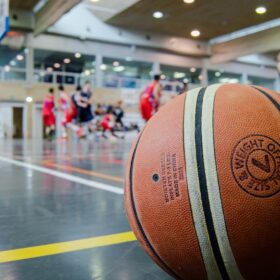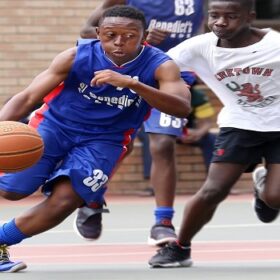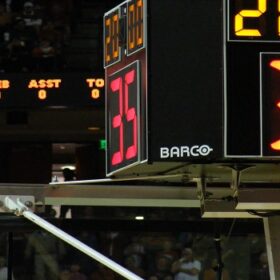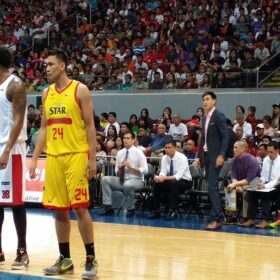Sportspersons have it tough on whichever field they represent. They feel pressured by the crowd, their coaches, and the constant attention placed on them by the commentators. Not to mention their self-fear and anticipation.
In such conditions, it is normal to let the pressure get to their head and make a mistake or two out on the field. However, the chances of these mistakes happening frequently are something that needs to be addressed ASAP.
Basketball, as an adrenaline-filled game, requires immense focus and quick court attention to dole out a good offense and defense. Wasting opportunities in the form of turnovers lead to clipped gameplays and rising frustration among the teammates.
Careless judgment can easily cost a well-played game. The coaches always focus on reducing turnover basketball plays.
Let’s take a broader look at what aspects turnovers reflect in and how they can be worked on effectively.
Quick Definition
Turnovers are generally due to poor gameplay by a player but are costly for the entire team.
Turnover basketball played for any reason drastically reduces the team morale and likelihood of making a good comeback.
What Are The Types Of Turnover In Basketball?
Turnovers are noticeably present in every game and make a profound impact on the overall score. They may be a wasted opportunity for one side. But represent an equally potential score maker for the other team.
Deciding on a turnover basketball play can be tricky since there are many reasons for its occurrence. There are two basic categories for turnovers in basketball.
Forced Turnovers
They are the result of an offensive player losing the ball to a defensive player. Loss of possession, in this case, is either due to poor judgment or impressive defensive play.
Both the teams try their best on the court for an opportunity to break the momentum in their favor. When a player dribbles up the court and is ready to make the shot but gets the ball swiped, it is said to be a forced turnover.
Sometimes offensive players are tackled into a corner and forced to make hurried passes that make their way into the offensive players’ hands.
There is, of course, a good chance of reducing forced turnovers. Better team play and quick communication play a decisive role in keeping the ball consistently in motion. Although, forced turnovers can be due to a robust defense kept up by the opposition.
Unforced Turnovers
This aspect of the game reflects the degree of practice a player imbibes from constant drills and passes. Unforced turnovers are a result of shoddy attempts at passes or ball receives that should be corrected immediately.
Maintaining the focus on the game and actively judging the trajectory of the ball is a must to avoid unforced turnovers. Feeble attempts at passing or dribbling and overpassing result in the defense making use of the opportunity handed to them.
The receiver and the passer must be in sync to make good gameplay. Reverting to the basics of basketball is a sound method of regaining control over unforced turnovers.
Why Do We Record Turnovers In Basketball?
Basketball has a fairly easy concept to understand. One team ensures more cracks at the hoop and gets the ball in more often than the other. Although this is a key thumb of a rule to follow, in the end, turnover basketball can turn the tide of the battle.
Tracking the presented data makes a crucial difference in controlling the general flow of the game. Moreover, coaches and players alike will have a hold on how their score is faring against the opponents.
Maintaining a positive turnover differential implies a better chance of winning the game. The more positive the turnover is, the lesser faults they have committed. At this point, the only way forward is to hold that momentum and push through.
Recording turnovers presents factual statistical data reflecting the game performance. Coaches have a filtered grasp of what elements of the game are working in their favor and which are not.
Similarly, instead of instructing the players to limit the turnovers, showing them the comparison works wonders. This way, they can focus one-tracked in retaining possession of the ball instead of being hung up on past mistakes.
Why Do Turnover Happen In Basketball?
The same way that fouls happen in any game, turnovers can crop up in basketball. They can be forced or unforced, but are an inevitable part of the battle.
In simple words, they can be a measure of superior defense and a lacking offense.
In the event of forced turnovers, the mistakes can be limited by positively addressing the issue. Coaches must ingrain the basics of the game through daily practice. Gameplays indicating the players to stay out of corners, dealing with dribbles and passes should be discussed.
Unforced turnovers are often the result of the ‘heat-of-the-moment’ passes due to mental constraints. They could certainly be due to a lack of playing experience in specific areas or an outright lack of practice.
In many cases, turnovers are the result of improper coaching and player practices in court. When there is a need to change players according to defensive positioning, coaches must follow heed.
Similarly, when a player is forced into a difficult situation, they must have the presence of mind to make a path through team communication.
Whatever the case, turnover basketball is a frustrating issue for coaches and players who tend to be harsh on themselves. Therefore, a proper understanding and assessment of individual and team plays can greatly curtail turnovers in a game.
How To Prevent Turnover In Basketball?
The crux of the fact lies in realizing that turnovers are not easily dismissed from gameplays. They are commonly encountered and must be taken into consideration to control the game thereafter.
In preventing turnover, basketball, coaches and players must have a firm understanding of the way’s turnovers are committed. Categorizing them as forced and unforced is not enough. Therefore, the issue has to be tackled at a deeper level to incorporate the appropriate countermeasures.
Some of the most common faults leading to turnovers are as follows:
- Double dribble
- Traveling or Walking
- Technical fouls
- Stepping out of bounds
- Ball handling
- Intercepted passes
- Steals
- Dedicated goaltending
- Charging
- 5-second violation, inbound
- 10-second dribbling violation
- Overpassing
- Foot passes/dribbles
There are fair chances of passing the ball to the opponent when focus on the game is disturbed. The above-listed turnovers are simply the beginning of a downward spiraling of the game. Tackling them head-on with proper coaching and analyzing is one way to deal with the after-effects.
As a coach, it may be imposing to talk about the turnover faults of any individual. However, the team might not be able to move forward with a clear mindset if the coach does not solve the issues.
Hiding or harshly pointing out the faults will have a negative consequence on the team morale. Instead, drive home the point by showing them the actual statistics. Doing this helps them formulate a solid plan to minimize their shortcomings.
Also, communicating the required gameplay to the players and its subsequent execution will determine the degree of negation of turnover basketball.
Key Takeaway
Players who regularly commit turnovers cannot aren’t ‘prone to turnovers.’ They may need pointers and experience on the court. Or they may be lacking in the basics of basketball discipline.
This adds additional responsibility to the teammates to balance out the turnover rate. However, it can also serve as a learning experience for the team as a whole.
Turnover basketball can be rectified with adequate team experience and skill development. It becomes imperative to stay calm through the field ordeal. As a result, the backing of a firm foundation in the basketball regimen goes a long way in tackling turnovers effectively.






